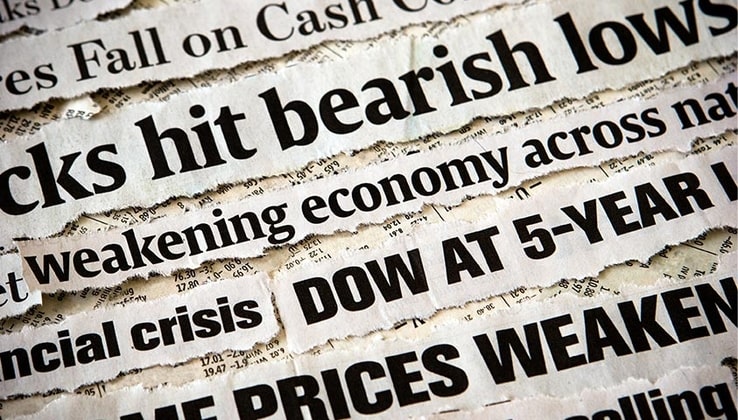CFDs are complex instruments and come with a high risk of losing money rapidly due to leverage. 72.2% of retail investor accounts lose money when trading CFDs with this provider. You should consider whether you understand how CFDs work and whether you can afford to take the high risk of losing your money.
- English
- Italiano
- Español
- Français
Here are five charts that give a glimpse at the health of a few corners of global markets - including gold, oil, and a weaker US dollar.
US500 - Fed assurance and the road to recovery
Chart source data: Metaquotes MT5
Stocks are recovering, perhaps too optimistically, but they’re recovering. Global benchmark index the S&P 500 (US500) has shown it’s prepared to defend the important 200-day moving average (black line) on its road to recovery, even if there’ll be significant bumps on the way.
Traders have learned that markets can mostly look through the discouraging COVID headlines and dismal economic data as a result of lockdowns. Provided there are no more mass lockdowns, the index looks ready to adjust to a new normal and reclaim those February-March losses.
Jaw-droppingly, the US Tech 100 index (US100) has already gone on to make a new record high.
The equity market has also learned that the US Federal Reserve has its back no matter what.
In fact, the US500, it seems, is a Fed-driven market. That most recent bear candle (11 June) in the above daily chart was spurred by a more dovish than expected statement from the Fed, as markets learned that easy policy was here to stay for the long-run. It was the largest daily move since mid-march, wiping out all gains made since the start of the month. Yet as price fell, it found strong support in that 200-day MA, a level above which stock traders tend to be bullish and bearish below.
All markets needed was another round of assurance from the Fed, and they got it the following Monday when the central bank announced it would begin purchasing a broad portfolio of corporate bonds under its Secondary Market Corporate Credit Facility (SMCCF) established in March. The index closed 2.4% higher from its open.
An interesting relationship here is that since mid-March, the US500 and the US dollar (see USDX) have tended to move in opposite directions. Risk-on sees the US500 up and USD down, and a risk-off mood the opposite.
So where to from here? Well the Trump administration is determined there will be no more mass lockdowns - they need a stronger economy for better re-election chances. So provided there is no more economic disruption in the US on such a large scale, the bulls will have a better chance taking this higher.
Many have noticed a disconnect between a rallying equity market and poor background economics. Equities represent future expectations, not the present, so will look through the current poor data prints. But for a cleaner read on economics and investor confidence, let’s look at the US Treasury market.
US 10 year Treasury yields, nominal and real
I like to look at the US Treasury market as an overall health check-up on the US and even global economy. This is because the US sovereign debt market is among the most liquid in the world and considered to be the safest available. For these reasons, treasury yields have historically represented the risk-free rate.
That means Treasury yields give a fairly clean read on economics: they rise when investors are confident and fall when pessimistic. Today, I’ve used the 10-year Treasury as a middle ground benchmark for our analysis.
Chart source data: US Department of the Treasury
You can see that the nominal 10-year yield (blue) hit a low in March, and has traded fairly flat since. Nominal yields have never been this low, and have been tracking a fairly steady downtrend since the 1980s.
But more importantly, I believe, is the real yield (nominal yield less inflation expectations).
Note that the real yield (orange) has fallen back towards its March low faster than the nominal. This is because inflation expectations are rising as traders look through the pandemic and toward a recovery. You’ll also have noticed the yield is trading in negatives. That’s right, investors are accepting a negative real return on Treasury investments. And if inflation expectations continue to rise faster than the nominal yield, that real yield goes deeper negative.
A notable data point from this week was US retail sales for May, which increased a massive 17.7% MoM against much lower expectations. Yes these are coming off lows and were -6.1% YoY. But if this is the first indication of the US consumer leading the recovery, which hadn’t been expected, there could certainly be a case here for inflation expectations to tick higher. And that could mean even lower real yields.
So why would an investor accept a negative real yield, you might ask? Many reasons. For one, several funds are mandated to hold a certain amount of treasuries. For the individual investor, it could be a perceived insurance premium against adverse economic times. At the same time, the Fed’s QE unlimited program will keep Treasury demand high and yields low.
Historically low yields show investors remain cautious, even if they are starting to lift on signs of optimism. I’ll explore later how low, or negative, yields could benefit gold. But let’s first consider how low yields will hurt the US dollar’s competitive advantage.
EURUSD - Has the euro gained a competitive advantage?
Chart source data: Metaquotes MT5
It’s been a rollercoaster for EURUSD this year. The euro spiked leading into March as COVID fears simmered and euro-funded carry traders were unwound, before a safety flight to the USD as markets continued to crash.
The euro held low as Europe faced some of the earliest - and deadliest - virus outbreaks, meanwhile the European Union (EU) failed to reach a fiscal relief agreement for member nations devastated by the virus. Debt mutualisation was the sticking point: fiscally conservative EU members preferred loans rather than the shared debt burden that Italy called for. The outlook has improved since, with Germany and France leading the path to a recovery plan in the form of grants.
An improving outlook, with economies coming out of lockdown, has lifted risk appetite and the EUR has since gained at the USD’s expense. So now that the euro is back in the top of its range, we ask where to from here?
Well the US dollar seems to be losing some of the competitive advantage it’s had over other major currencies for several years now. The biggest change to this, I think, has been the slashing of the Fed funds rate to near-zero. A hawkish Fed until 2019 saw relatively high US interest rates, compared to ECB rates at 0%. Higher-yielding assets gave the US dollar a competitive advantage, which has been eroded now that the Fed funds rate is once again at the zero-lower bound. The Fed’s commitment to easy policy means tightening isn’t on the agenda for a very long time.
It’s also an election year in the US, which could subdue the USD on election hedging.
The euro finds strength in policy unity across the bloc, so if the EU can make a meaningful move towards fiscal unity, the euro should further appreciate.
In the short-term, I’m watching 1.1210 as a support level for pullbacks and I expect 1.1400 to provide a strong resistance level when the euro tries to grind higher.
What changes the upward trend in EURUSD? A second wave and the chance of more lockdowns, both of which would see a safety flight towards the USD again.
Gold
Chart source data: Metaquotes MT5
Gold (XAUUSD) continues to hold the 1700 handle as investors purchase the metal to hedge risk, but it hasn’t managed to hold above 1745 despite testing the level several times since early April.
This tells me that gold is happy to hold these valuations, the highest since 2012, but needs conviction for the next move higher. In what form this comes is uncertain yet, but history tells us the case for gold is as bullish as ever.
The US Federal Reserve has made it clear that easy monetary policy is here to stay, as have other major central banks. In the years following the 2008 financial crisis, gold rode a wave of policy uncertainty to a record high of 1920 in 2011. With near-zero rates once again, QE now unlimited, low Treasury yields, and more major central banks on the QE bandwagon, I expect new record highs in the coming years.
But for now, we wait for a sign of the next move higher. I want to see a break above 1745 on a daily closing basis to signal the bulls can take this towards 1790, a strong resistance level from 2011-12. Do note the failed break above 1745 in May, where a bearish daily candle couldn’t hold the higher levels.
I’m also watching the 50-day EMA (purple) to guide any pullbacks, which I see as buying opportunities. The indicator seems to have softened the early June drawdown.
WTI crude (XTIUSD) - a slow recovery
Chart source data: Metaquotes MT5
The oil market has started to recover since price collapsed and May futures traded to negative prices upon expiry. Global demand had dried up amid pandemic lockdowns, while producers ramped up production in a price war, drowning markets in crude oil no one needed.
The outlook is a little better now but price remains sensitive to the virus, particularly as concern ramps up on a second wave. Price has been choppy as XTIUSD navigates the 34.5 to 40 range, pausing this week as Beijing reimplements lockdown measures to curb a second wave, while several US states continue to see rising case counts.
34.50 is a key level in the short term. It was a resistance level ahead of June, and trend reversal has seen it now become support. Consider that the Trump administration remains opposed to future lockdowns, requiring a stronger economy for better re-election odds in November. Continued freedom of movement will help the oil market, and this 34.5 level should hold provided we don’t see major lockdowns again.
US crude stockpiles continue to rise despite OPEC+ members mostly sticking to agreed production cuts. The demand just isn’t catching up quite yet.
Looking ahead, WTI will need conviction to trade above $40/barrel in the near-term. That conviction could come in the form of lower US crude stockpiles, and of course improving virus case counts across the globe and efforts to mitigate a second wave.
Related articles
Ready to trade?
It's quick and easy to get started. Apply in minutes with our simple application process.
The material provided here has not been prepared in accordance with legal requirements designed to promote the independence of investment research and as such is considered to be a marketing communication. Whilst it is not subject to any prohibition on dealing ahead of the dissemination of investment research we will not seek to take any advantage before providing it to our clients.
Pepperstone doesn’t represent that the material provided here is accurate, current or complete, and therefore shouldn’t be relied upon as such. The information, whether from a third party or not, isn’t to be considered as a recommendation; or an offer to buy or sell; or the solicitation of an offer to buy or sell any security, financial product or instrument; or to participate in any particular trading strategy. It does not take into account readers’ financial situation or investment objectives. We advise any readers of this content to seek their own advice. Without the approval of Pepperstone, reproduction or redistribution of this information isn’t permitted.


